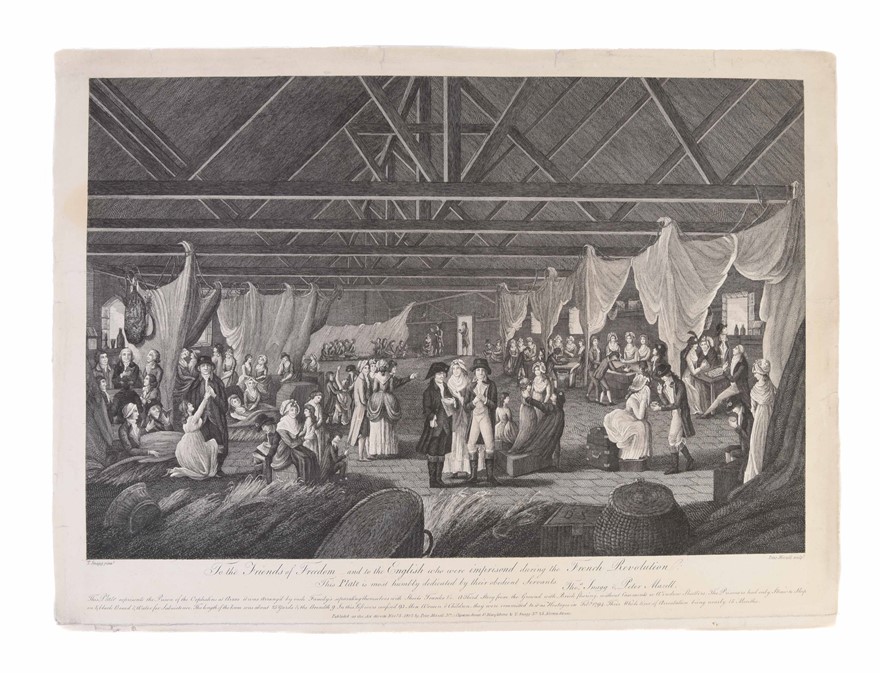To the friends of freedom and to the English who were imprisoned during the French Revolution;
SNAGG Thomas artist (1802.)
£3500.00
Please contact us in advance if you would like to view this book at our Curzon Street shop.
ENGLISH PRISONERS OF WAR DURING THE TERROR
this Plate is most humbly dedicated by their obedient Servants. Tho^s^ Snagg & Peter Mazell.
Engraving (360 x 485mm). Trimmed to the plate mark at the upper and left and right margins, some old chips to the margins repaired (not touching the image), two small brown spots in the centre of the plate (not visible until held to the light).
[London]: by Peter Mazell...and T. Snagg, Nov 5th 1802
David Bindman Shadow of the Guillotine: Britain and the French Revolution no.150. We have located copies at the British Museum, Wellcome Library and the Bibliothèque Nationale. The British Museum copy has what appears to be a unique key to the engraving providing the identity of the figures in the engraving.
An astonishingly personal portrait of the English prisoners brutally held in a disused convent in Arras during The Terror. The engraving includes a self-portrait of the artist, Thomas Snagg, alongside his son who died during his confinement due to the living conditions.
The caption below the image states:
"This plate represents the Prison of the Orphalins at Arras it was arrang'd by each Family's separating themselves with Sheets Trunks &c. a third story from the Ground with Brick flooring, without casements or Windows Shutters. The Prisoners had only Straw to Sleep on & black Bread & Water for subsistence. The length of the room was about 25 yards & the Breadth 9. In this loft were confin'd 93 Men Women & Children, they were committed to it as Hostages in Feb^y^ 1794. Their Whole time of arrestation being nearly 15 Months"
The engraving shows the room on the upper floor of the disused Convent "Les Orphelins" in Arras in France where over seventy individuals are depicted in the makeshift prison. A key (which accompanies a copy of the print in the British Museum) identifies the majority of the people depicted including a group of men on the left as the "President and Tutors of the College of St Omers". The ten small boys at the back of the room are "youths of the College". The president of the College is reading from a book, perhaps performing a religious ceremony (the key can be viewed here: https://www.britishmuseum.org/collection/object/P_1864-0514-212).
Thomas Snagg (1746-1812), the artist, is shown in the foreground sat with his family on a wooden trunk. Thomas is sketching while his wife (Sarah) is comforting their two daughters while their son (who died in the prison of "privation and exposure" - see Recollections of Occurrences, the Memoirs of Thomas Snagg, with an introduction by Harold Hobson, printed in a handsome edition with woodcut illustrations by the Dropmore Press in 1951, xix) is shown with his back to the rest of his family playing with a toy. Snagg was born in London into a family of upholsterers but became an actor before later touring Europe and visiting Russia. It was on his return from Russia that he was arrested while passing through France and imprisoned at Arras.
Along the right-hand side of the image are four makeshift stalls separated by posts and sheets in which various families have settled. The families are (according to the key) the de la Fontaines, the Harwoods, the Dightons and the Gordons. The families are shown being waited upon by servants and the Gordons are playing a game while the father looks out of the open window.
The three figures in the centre of the image are, on the left, wearing glasses, Mr Stratton; in the centre, Mrs Rousseau and on the right Mr Baker.
The "Reign of Terror" which spread across France in 1793 and 1794 under Robespierre saw thousands of so-called enemies of the Revolution summarily arrested and tried in dubious courts with many of them being condemned to execution by guillotine. Foreign nationals were deemed to be a risk and so groups - like those pictured in this image - were rounded up and imprisoned in makeshift quarters. Religious groups were also persecuted which no doubt led to the tutors and students of the Catholic College St Omer also being imprisoned.
Charlotte Smith (1749-1806) writes movingly of the situation in France (and particularly Arras at this time):
"Arras is the common prison of the department, and, besides, there are a number of other houses and convents in the town appropriated to the same use, and all equally full. God knows when these iniquities are to terminate! So far from having any hopes at present, the rage for arresting seems, I think, rather to increase, than subside. - It is supposed there are now more than three hundred thousand people in France confined under the simple imputation of being what is called "gens suspect" Charlotte Briggs A residence in France, during the years 1792, 1793, 1794, and 1795 (1798) p230-1
"Les Orphelins" survives today as Collège Jehan Bodel.
The plate is a remarkable composition: the numerous figures are highly intriguing with some looking towards the light (and freedom) through the open windows, some on their knees weeping and others being comforted by their fellow inmates. The whole scene is carefully framed by dark straw and baskets along the lower edge, the ghostly hanging sheets at each side and a masterfully rendered geometric assemblage of beams above.
Stock Code: 247459




